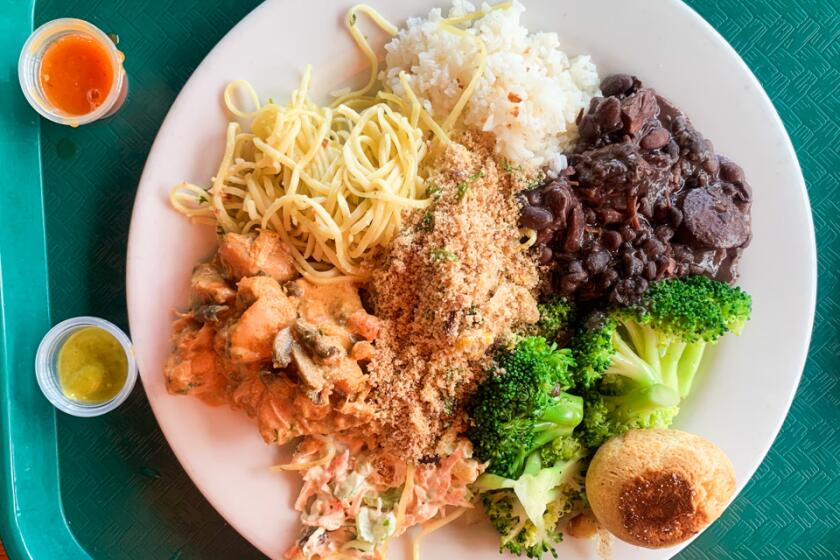Refreshing the recipe rules of L.A. Times Cooking

Recipes are like language, full of implicit meanings that are foreign to the uninitiated, first-time cook. Certain aspects that seem efficient to the professional will seem cryptic to the novice — as anyone who has watched “Schitt’s Creek” can attest, the directive to “fold in” an ingredient is not as easily understood as those of us who write recipes may think. It leads to plenty of head-scratching moments for readers and recipe developers alike.
After a year of getting more feedback than ever from a large crop of novice cooks — who sought our content during the shutdown last year — about recipe instructions that confuse them, I decided to pull back the curtain on some of the processes and thought that goes into writing a recipe. My hope is that you will see the intention in the writing and that the directions will then make sense. Recipe developers take a lot of language in recipes for granted, but it’s helpful to occasionally step back and reevaluate why we write what we write.
Recipe writing is not infallible, and one of the greatest lessons I ever learned from a former boss is this: It’s a living, breathing style of writing that must adapt with the times. Some parts of the process make sense to the creator and readers alike — “Bring a large pot of water to a boil.” Others don’t fit our digital world any longer — writing in shorthand that is meant to save space in a print format — or they include ingredients such as “1 whole chicken, butchered into 8 pieces,” which assumes a skill that most novice cooks in 2021 probably don’t have. Regardless of whether things change, knowing the reasons why there are rules to begin with is half the battle.
So, to kick off a new year of cooking informed by the lessons learned from the previous 12 months, here are “The New Rules of Cooking” at the L.A. Times. These are changes that will improve our recipes and in turn, improve your results, empowering you to make better meals in the year ahead.
Headnotes
When a recipe is connected to a story, the two parts need a bridge. When you encounter a recipe by itself, it needs context as to why it exists. Both are the job of a headnote, the block of text that runs between a recipe’s name and the ingredient list. A good one provides background information on techniques, ingredient preparations or sourcing information that would feel incongruous within the actual steps of the recipe. Some people argue that information in a headnote should simply exist within the recipe steps themselves, but I disagree. Recipe steps should be prescriptive and easy to follow. Interrupting directives on the sequence of adding ingredients to a soup, for example, by talking about the origin of a special tomato paste would make for a cumbersome experience. At best, headnotes contain vital information for the recipe’s success; at least, they provide the optimal scenario in which to serve the dish or how best to enjoy it. So, always read them.
Weight Measurements
For those of us who write recipes, there has been no more difficult sell to readers the past decade than convincing them to use a digital scale when it comes to baking. It involves asking readers to purchase a piece of equipment, and so many writers — pushed over the years to write lo-fi recipes that require only a pan and a spoon — see it as unnecessary, and instead continue to ask for less accurate volume measurements.
Meanwhile, the majority of reader comments and emails that my fellow recipe developers and I have received during our careers are about baked goods coming out too dry. Ninety-nine percent of the time, this is due to people packing the flour into volume measuring cups. Even though I love Ina Garten, I attribute a lot of this to her and her show “The Barefoot Contessa” — arguably no more formative a cooking show to the current generation of home cooks — which shows her scooping measuring cups into canisters of flour. However, recipe developers who work for major food magazines, newspapers or online publications measure their flour by spooning it lightly into a cup, then leveling the top with the flat edge of a knife. These two distinctly different methods of measuring cause lots of discrepancies between how the developer creates and how the mainstream reader cooks, allowing for wildly varying amounts of flour to make it into your cakes, cookies and loaf breads.
But the one thing that would solve all this, the one thing that professionals and bakers outside of the U.S. have known for decades? A digital scale. It allows you to accurately measure flour, powdered sugar and other easily compacted dry ingredients and you can, obviously, use it to weigh other things such as portions of meat or irregular lumps like bread cubes, which don’t fit neatly into volume measuring cups, or delicate herb leaves, which can halve their volume depending on how “packed” they are in the cup. And unlike pricey stand mixers or food processors, a digital scale is cheap, and you will use it every day. It also cuts down on the number of dishes you have to wash since you don’t really need to use dry measuring cups anymore. (As for liquid measurements, since liquid measuring cups have both U.S. cup and metric milliliter measurement markings as a standard, we will continue to call for cup measurements first but then also add milliliter measurements in parentheses afterward.)
Over this past holiday baking season, I finally got enough reader feedback asking for weights to convince me that home cooks desire weight measurements for baking recipes more than old-fashioned volume cups. So, from this point forward, all our baking recipes will list ingredients — where applicable — with metric weights first, followed by volume measurements in parentheses. My hope is that this simple change will gently nudge you, if you don’t already own one, to finally get a scale and use it. I promise you’ll never worry about making dry baked goods again and your overall cooking will benefit from it.
Salts
There is no more important ingredient in your cooking than salt, but at the same time, it’s the most argued over. There are dozens of brands, and each one is made using a particular process. If you’re an experienced cook with knowledge of how to season your food well and when to use each type of salt, this is a fun world to explore. If you’re a first-timer, however, it can be exhausting to wade through.
If you’ve noticed in the past couple of months, we went from listing salt in our recipes as “kosher salt” to then “kosher salt, preferably Diamond Crystal” to finally, explicitly “Diamond Crystal kosher salt.” This change came about because we realized that not all kosher salts are created equal, and we want to equip you with what we consider to be the best. It’s also the salt we use when developing recipes for the L.A. Times.
The main two brands you’ll find at most grocery stores are Diamond Crystal and Morton’s. Diamond Crystal earned widespread use in restaurant kitchens because it feels pleasurable in the hands of line cooks who need to evenly season food, and it has a clean, pure taste, a departure from the iodine-laced table salt used by past generations that can give your food a chemical aftertaste.
That preference has seeped into recipe writing via former restaurant cooks who went to food magazines and newspapers and television networks to work as recipe developers. Thus, “kosher salt” became the de facto choice. To avoid giving free advertising to one single brand, articles popped up every few years reminding readers that Diamond Crystal is the salt to use, but it was not listed explicitly in recipes. This led to lots of confusion, allowing readers to think they could buy Morton’s brand and the recipe would work out fine. And indeed, if you’re simply seasoning your food “to taste,” then you can use any salt you want since the salt level is up to you to adjust.
But when it comes to recipes that require a measured amount of salt, that approach is disastrous. Morton’s kosher salt is denser, and its flakes are bigger than Diamond Crystal. In various other publications, I’ve seen a range from as little as one-quarter to as much as half the volume amount of the measurement of Diamond Crystal to equal Morton’s. But judging by weight per volume, Morton’s is around 37%, or roughly one-third, heavier than Diamond Crystal. So, for every 1 tablespoon Diamond Crystal kosher salt, you’ll want to substitute it with about 2 teaspoons Morton’s to keep the salinity the same. If your recipe calls for a weight of salt, then you can use either kosher salt interchangeably.
To avoid any ambiguity once and for all, we’re explicitly calling for Diamond Crystal kosher salt in our ingredient lists. If you plan to stick to Morton’s, know that you will need to do the math each time to use it in our recipes.
And when it comes to salt in baking, the conversation becomes not about brands, per se, but about the size of the salt crystals. Similar to how bartenders will call for superfine sugar in cocktail recipes because the smaller crystals of sugar dissolve quicker than regular granulated sugar, so too does finely grained salt dissolve quicker and more evenly into baked goods than the comparatively larger-grained crystals of kosher salt. But if you look at our baking recipes even now, we call for kosher salt. That’s because we assumed if there was only one salt that cooks will have, we should stick with it across the board so as not to burden readers with having to buy another type of salt. But in reality, you really should use fine sea salt in baking recipes for its smaller crystals.
Quick explainer: Fine sea salt is made by evaporating seawater and then crushing the resulting salt flakes (i.e., “flaky sea salt”) into fine crystals. Kosher salt can be made from evaporated seawater or mined from a salt cave. It gets its name from its use in the process of “koshering,” whereby blood is drawn out of meat so it adheres to Judaism’s religious dietary practice. The important criterion is the size of its crystals: Too fine and the crystals dissolve in the moisture on the outside of the meat; too large and they don’t adhere at all. Kosher salt’s Goldilocks crystal size came about for its ideal use in this koshering process. It also happens to make the best-sized salt grains for grabbing by the “pinch.”
After a food magazine that I worked for several years ago made the switch to calling for “kosher salt” for both its cooking and baking recipes, one of my baking mentors — cookbook author and teacher Nick Malgieri — commented to me that kosher salt’s grains are too big and will lead to pockets of salt surrounded by bland dough or batter. I couldn’t reverse the decision myself then but he was right. Can you use kosher salt in baked goods and have them work out fine? Of course. But if you use a fine-grained salt, the seasoning gets more evenly dispersed, making each bite taste better.
It’s with that thinking that, in our baking recipes, we will start calling for “fine sea salt” followed by the equivalent measurement of kosher salt in parentheses. Similar to using weight measurements, this will convey the importance of using fine-grained salt for the best results but allow you to fall back on kosher salt for the time being.
Ingredient Lists
I’ve always operated from the point of view that ingredient lists should read like grocery shopping lists unless there’s a crucial need for an alternative. It’s an outlook that one of my former bosses — Tina Ujlaki, the longtime food editor at Food & Wine magazine — impressed upon me, and it has proven to be the most efficient, especially for readers who build their shopping lists from ingredient lists in recipes. Here is the breakdown of that outlook, showing how different ingredients are formatted depending on their use:
Let’s say, for example, a soup recipe calls for “1 large yellow onion, roughly chopped”; the words “large” and “roughly” are very subjective. But if the size of the onion, or how big you cut the pieces, doesn’t affect the outcome of the finished dish in a noticeable way, I will leave it that way so that you know to buy a “large” onion and then chop it — the yield you get is the yield you get and there’s no fiddling with measuring precise amounts. It is, ostensibly, a more relaxed way to cook.
However, if a recipe really depends on a precise amount of that onion, that’s when I’d call for something like “1 cup diced (¼-inch) yellow onion” to give you an exact yield. This is typical of recipes such as meatballs, where precise measurements affect the finished product in an obvious way. If I called for “finely chopped onion” for those meatballs, then five people’s opinions on what constitutes a “fine chop” would result in five very different-looking meatballs. Some might hold together perfectly while others would barely adhere at all.
Along those same lines, if an ingredient is to be served with a dish — say, “cooked rice, for serving” for gumbo, or “chopped cilantro, to garnish” for tacos — we don’t give measurements because the inclusion of the ingredient, or its precise amount, is not critical to finish making the dish. Similarly, if we list an ingredient with no directive at all, that simply means it will be used in the dish but the amount used will be up to the cook to decide according to their taste (“freshly ground black pepper”). Lastly, if you see an ingredient with the words “divided” after it, that means you will need to use it more than once in a recipe, so read the recipe thoroughly before you start cooking to see how the ingredient will be divided and where it will be used.
As for the order in which ingredients are listed in recipes, the most important tactic is, obviously, to list ingredients in the order in which they are used in the dish. However, when groups of ingredients of various sizes and weights are called to be used at the same time, you might come across a listing like this and wonder how it ever came to be:
- 2 ounces ground beef
- 1 teaspoon ground cumin
- 4 large yellow onions, thinly sliced
The onions are clearly the largest physical amount of the three ingredients, so why are they listed last? I operate on a rule of first listing weighted ingredients (grams, ounces, pounds), followed by volume-measured ingredients (cups, tablespoons) and then, finally, numbered pieces of whole ingredients (“2 carrots,” “8 potatoes,” etc.). While it may seem counterintuitive to the way a cook may add the ingredients in their kitchen, that approach is, in my opinion, the only way to standardize the recipe-writing process.
Along the same lines, when it comes to, say, several ground spices listed together that have the same measurement, I arrange them in alphabetical order (“ground cardamom,” “ground cinnamon,” “ground cumin”). It offers some organization and consistency to an otherwise chaotic, infinitely subjective system.
Water
Of all the ingredients you use in a recipe, you may notice that when a specific amount of water is called for, it’s not listed in the ingredient list but rather in the recipe step where it gets used. This anomaly is primarily a leftover from the days when recipe developers were print-centric. Water, which is a “free” ingredient that no one needs to buy, became something that could be moved to recipe steps to help save precious room in print where each ingredient line takes up an entire, very valuable line of real estate on the page.
In recent years, I’ve received a lot of feedback from readers wishing the water was listed in ingredient lists so they could have it prepped and ready to go with the rest of their ingredients. And it’s a great point: If recipe writers are so dogmatic about mis en place — preparing all your ingredients in advance so they’re lined up and ready to be used before you start cooking — why leave out an ingredient that can be a major factor in the outcome of the dish? It’s for that reason that we will start including water in ingredient lists when it’s needed in a measured amount. However, water needed to fill a pot for boiling pasta, for example, will remain as such in the recipe’s steps.
Substitutions
As someone who creates recipes for readers in arguably the most health-conscious city in the U.S., I get a lot of questions about substitutions to make our recipes fit into particular diets. Whether it’s swapping out coconut oil for butter, rice flour for all-purpose flour or cashew cheese for sour cream, people want to know what they can adjust and what they can’t. I understand these questions and welcome them — I too make questionable substitutions at home that sometimes aren’t successful, but at least I know why they failed.
For the novice cook, it may seem like any flour can be swapped for another to make something gluten-free, but the reality is disappointingly far from the truth. There are whole books written on this subject, but what I will say is that most recipes are created to work as written. There is sometimes wiggle room for substitutions, and hopefully the creator will have anticipated your needs — something we all got better at during the beginning of quarantine last year — and offered up some helpful swaps in the headnote of the recipe.
From the perspective of the recipes at the L.A. Times, our recipes will start including more notes on substitutions. If it’s a simple swap (crème fraîche for sour cream in a cake, for example), then the substitute will be listed in the ingredient line. If there are multiple substitutions, or the substitution requires a more complex explanation, look for it in the headnote or in a special note after the recipe. The key takeaway from all this: Read every part of a recipe before you cook to ensure the greatest chance of success.
More to Read
Eat your way across L.A.
Get our weekly Tasting Notes newsletter for reviews, news and more.
You may occasionally receive promotional content from the Los Angeles Times.







